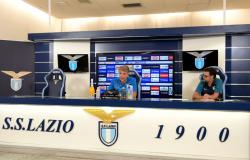The 2024 Italian Grand Prix is baking – 3°C hotter (at 34°C ambient) than in the 2023 Monza race so far, with a near 10°C accompanying rise on track temperatures. This may well combine with the major track surface change here to significantly alter race strategy.
Again this term, four Formula 1 teams seem to be in the hunt – based on what we’ve seen so far in Monza practice. Their identities will be no surprise.
But each of Red Bull, McLaren, Mercedes and home favourite of the leading quartet, Ferrari, have made a positive start to the track action at Monza. Only at Mercedes, which had Andrea Kimi Antonelli crash just 10 minutes into his F1 weekend debut, was there a clear down note on the day.
The Silver Arrows squad’s drivers were also complaining of a severe seat heat problem during FP2, while F1 finally got to see the true impact of the controversial track kerb changes at this legendary venue when the pack rolled out on Friday afternoon. And while Red Bull might not have been unable to show any performance running today, the feeling aboard the RB20 for its drivers is much happier than a week ago at Zandvoort.
Here then, is everything we learned from Friday practice at Monza, which offers an insight into how Sunday’s 2024 Italian GP might go for the frontrunners.
The story of the day
Andrea Kimi Antonelli had begun FP1 promisingly before crashing out at the Parabolica
Photo by: Zak Mauger / Motorsport Images
The Renault engine staff protesting in the Monza stands did so with great dignity from Autosport’s point of view at the pit exit at the start of FP1. The group in the grandstand opposite here – there was another in a tribune just before the finish line too – politely applauded Esteban Ocon and Pierre Gasly as they took their Alpines out on track at the session’s commencement.
We then headed for the famed Ascari chicane – where we saw how unlike with the previous savage, narrow kerbs at this sequence, the drivers are now throwing their machines onto the new, flatter variety. But although the line is slightly altered, at this stage of the weekend, the trackside spectacle is generally unchanged.
In the opening session, Antonelli went quickest on his first flying lap early on softs, then was set to go even quicker on his second run a few minutes later. But his tyres cried enough at the Parabolica and he spun off backwards – smashing George Russell’s W15 against the barriers.
Later, Max Verstappen shot to head FP1 with a late 1m21.676s flier, with Charles Leclerc and Lando Norris finishing second and third for Ferrari and McLaren respectively. The trio were covered by just 0.241s.
FP2 overall times
| Pos | Driver | Team | Time | Gap |
| 1 | Hamilton | Mercedes | 1m20.738s | |
| 2 | Norris | McLaren | 1m20.741s | +0.003s |
| 3 | Sainz | Ferrari | 1m20.841 | +0.103s |
| 4 | Ricciardo | RB | 1m21.300 | +0.562s |
| 5 | Alonso | Aston Martin | 1m21.316 | +0.578s |
| 6 | Botched | Sauber | 1m21.461 | +0.723s |
| 7 | Magnussen | Haas | 1m21.499s | +0.761s |
| 8 | Albon | Williams | 1m21.592s | +0.854s |
| 9 | Verstappen | Red Bull | 1m21.610s | +0.872s |
| 10 | Gasly | Alpine | 1m21.819s | +1.081s |
Mercedes working to repair Antonelli’s damage meant Russell missed nearly half of FP2 and so did a run plan much different to the rest. He popped in a time that elevated him from last to sixth in the closing minutes, while Hamilton led the way on a 1m20.738s.
Max Verstappen didn’t manage to post a time on softs during the second session staged on the newly-resurfaced Monza layout
Photo by: Steven Tee / Motorsport Images
This came on the second of two soft tyre runs he completed on the same set of C5s just before Kevin Magnussen crashed and stopped FP2 with his off backwards and into the Lesmo 2 barriers.
Like Hamilton, and with a similar quick trip to the pits for a front wing flap adjustment, Norris had also gone quicker with his second set of softs but ended up just 0.003s slower than his Mercedes rival.
Oscar Piastri might’ve beaten them both, having set personal best sectors in Monza’s first two thirds on his first of two soft-shod fliers (with his second significantly slower, unlike for the leaders). But having to save a big oversteer snap exiting the third Ascari apex cost Piastri so much time running down the back straight he ended up 0.120s off Hamilton’s leading effort.
The obvious rebuttal to this interpretation of the data is that a more experienced driver would’ve known not to attack so hard so early and raise the tyre temperatures to the point they risked a crash later in the lap
Red Bull missed slotting in a true performance run here as Verstappen had to correct an oversteer snap to avoid his own Antonelli-like Parabolica shunt and so backed off from the runoff on what became his sole FP2 softs flier attempt due to Magnussen’s shunt.
For Sergio Perez, a gearbox issue being detected between Friday’s sessions meant he was another late FP2 starter. And although he tried a flying effort after the session restarted post-red flag, he wound up well off the pace and complained about “a few mechanical issues because we had to put the car together quickly” costing him time.
The Ferrari drivers were able to slot into third and fifth in FP2’s best times just before the Magnussen shunt, with Carlos Sainz leading the way for the Scuderia, 0.103s off Hamilton’s top time.
What the data tells us
The GPS traces have provided lots of information about Antonelli’s crash – with the Italian clocked hitting the highest speed through Lesmo 2 for all of FP1 and then having a higher minimum speed (by 8.6mph) than Verstappen on FP1’s quickest lap at Ascari just before he crashed.
He ultimately did so because these speeds had taken so much life from the soft C5s on Russell’s W15 at the time. Mercedes team boss Toto Wolff said afterwards that “what we have seen in one and a half laps is just astonishing”. So, it’s clear how Mercedes is trying to spin this, but the obvious rebuttal to this interpretation of the data is that a more experienced driver would’ve known not to attack so hard so early and raise the tyre temperatures to the point they risked a crash later in the lap.
Toto Wolff defended Antonelli after the young charger crashed in FP1
Photo by: Sam Bagnall / Motorsport Images
But, this is also just how rookies find the right limit and Wolff is entirely correct to also insist “I’d rather slow somebody down than make him fast, because the second one is impossible”.
The GPS data also indicates that even if Verstappen had completed his FP2 softs flier, he was running in a conservative engine mode and so has much more potential to come over one-lap. Red Bull motorsport advisor Helmut Marko said of this: “Until that point [where Verstappen went off] he was two-tenths behind Norris but not with the normal engine power, like the others had.”
Potentially critically for Red Bull, its drivers and fans, Marko reported “we are much better than in Zandvoort” on the balance issues that wrecked things for Verstappen last time out at his home race.
Medium long-run averages (top four constructors’ teams only)
| Pos | Team | Average | Stint length |
| 1 | Red Bull | 1m25.399s | 14 laps |
| 2 | McLaren | 1m25.507s | 11 laps |
| 3 | Mercedes | 1m25.529s | 13 laps |
| 4 | Ferrari | 1m25.612s | 13 laps |
The track changes played havoc with the FP2 long-runs, with one team source suggesting the times logged above must be treated with extreme caution because the drivers just haven’t yet figured out how best to push over a long stint on the new surface.
The tyre range is the same C3-C4-C5 selection as in 2023. But the new surface and hotter temperatures are combining to produce severe surface graining on the softs and mediums.
As soon as a driver pushed on in FP2, the issue bit them and their pace dropped. The hard basically hasn’t appeared as the teams are really trying to save these sets for the race. But, as far as the times can be relied upon for this reason, Red Bull ends Friday on the up in the long-run stakes.
Adding to the positivity for Verstappen’s squad, which has the RB20 back in low-drag specification with those high-waisted cooling gulleys, is that his FP2 long run was the longest of all the front runners at 14 tours. Although, only just.
Verstappen impressed with his times on long runs, offering hope for Red Bull after its Zandvoort defeat
Photo by: Sam Bloxham / Motorsport Images
The other main point to note is just how close things look across the leading teams, which applies to the performance runs for them too (except for Red Bull, obviously).
And although Ferrari is clocked at the back of the averages right now, Leclerc did set off pushing harder than any of his rivals and so paid the price on the graining factor. He also said, “driving the car felt nice and the upgrades we brought to the car are working as expected”.
Mercedes is just one week on from topping FP2 and then fading, so it’s wary of getting away with topping the second session at Monza just as it did at Zandvoort (there with Russell). Piastri’s Ascari wobble and Verstappen’s flying lap absence are key factors here.
The hot seat issue that was affecting Hamilton and Russell in FP2 also hasn’t been fully diagnosed, but Autosport understands that, as well as a possible rising ERS temperature theory, the most likely explanation is the W15s planks are rubbing all the way along the long Monza straights and so sending high-temperature spikes quickly to the drivers sat just above.
One way to solve this would be to raise the car slightly, with Mercedes also acknowledging that the car and its plank rubbing on the straights – and more on the kerbs here than ever before thanks to the track changes – mean it could be giving away a slight performance/time edge with this too.
How the track evolves from here will be key to who wins the Italian GP. With no rain expected, it will grip up significantly and this is predicted to help with the graining issue.
But right now the teams are working hard to assess whether or not this race has changed from a nailed on one-stopper (because of the big pitlane time loss factor) to the two-stoppers that Friday’s graining issue indicated is now a real possibility. Pirelli thinks the severe pitlane penalty – due the high speeds drivers still out can clock as rivals trundle along at the speed limiter – means the teams could yet be forced to employ major tyre management tactics.
While hardly stuff to get the pulses racing on paper for fans, it could meant an interesting pitstop timing affair and mean the Monza DRS trains that have characterised modern races here and made the overtaking challenge tricky can be broken, therefore improving the racing spectacle after all.
Can Hamilton stay at the front for qualifying, or will Red Bull and McLaren spoil his efforts to impress the tifosi?
Photo by: Steve Etherington / Motorsport Images






